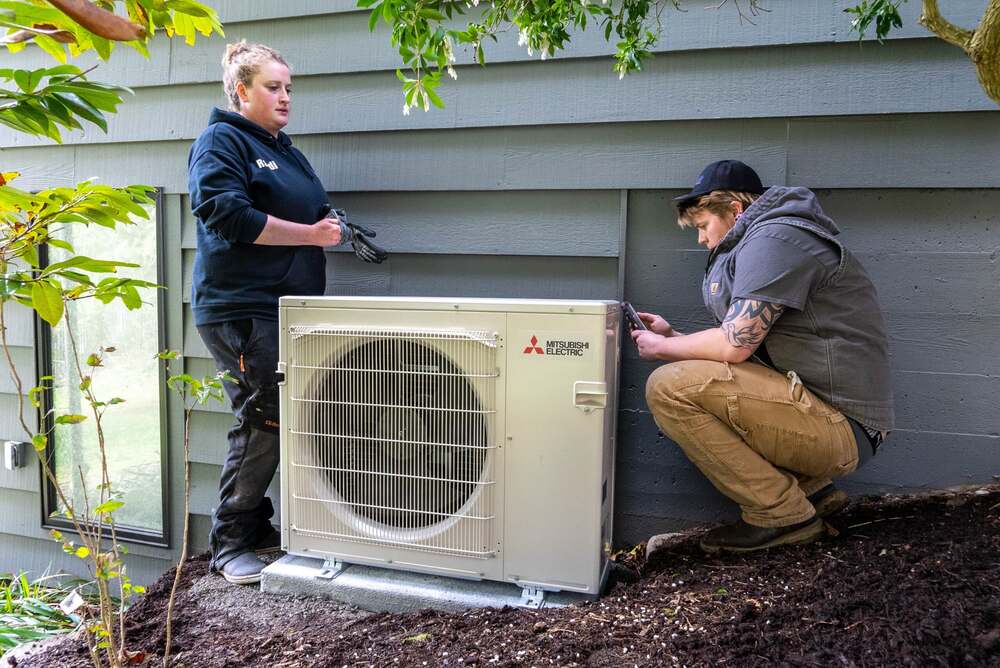The Importance of Proper Mini Split Sizing
When it comes to how to size a mini split system, getting it right is crucial for both your comfort and your wallet.
Here’s the quick answer you might be looking for: To size a mini split system, you need to calculate the square footage of each room and then multiply by 25 to get the BTUs needed. For example, a 100 square foot room requires about 2,500 BTUs. Consult an HVAC expert for a precise load calculation considering other factors like ceiling height, windows, and insulation.
Why is proper sizing so important?
- Efficiency: An accurately sized unit operates more efficiently, reducing energy waste.
- Comfort: Proper sizing means consistent temperature, eliminating hot or cold spots.
- Energy Savings: Efficient operation translates to lower utility bills.
- System Longevity: Correct sizing prevents overworking or underutilizing the system, prolonging its life.
Properly sizing a mini split ensures you get the most out of your investment with the least amount of hassle.

Why Proper Mini Split Sizing is Crucial
Proper sizing of a mini split system is essential for several reasons, impacting everything from performance to lifespan. Let’s break down why getting the size right is so important.
Performance and Efficiency
A mini split system that is correctly sized for your space will perform optimally. This means it can efficiently and effectively cool or heat your home. Inverter technology in mini splits allows them to adjust their output to meet the exact needs of your space, but this only works well if the unit is the right size.
Undersized Units: If your mini split is too small, it will struggle to maintain the desired temperature. This leads to the unit running continuously, which wastes energy and fails to keep your home comfortable.
Oversized Units: On the other hand, a unit that is too large will short cycle. Short cycling is when the system turns on and off frequently, which not only wastes energy but also wears out the system faster.
Lifespan of the System
The lifespan of your mini split system is directly affected by proper sizing. An undersized unit will work harder and longer to try and heat or cool your space, leading to faster wear and tear. This can cause frequent breakdowns and a shorter overall lifespan.
Oversized Units: These systems experience short cycling, which also leads to faster wear and tear. The frequent on-and-off cycles put a strain on the system’s components, causing them to fail sooner.
Comfort and Energy Savings
Properly sized mini splits ensure consistent comfort. An accurately sized unit will eliminate hot or cold spots in your home, providing even temperature distribution.
Energy Savings: Efficient operation of a correctly sized unit translates to lower utility bills. You’ll save money on energy costs because the system won’t be overworking or underperforming.
Avoiding Common Issues
Short Cycling: This is a major issue with oversized units. It not only reduces the lifespan of the system but also leads to poor humidity control. Your home might feel cool but damp, which is uncomfortable and can lead to other problems like mold growth.
Undersized Issues: An undersized mini split will continuously run, trying to meet the temperature demand. This not only increases your energy bills but also fails to provide the comfort you need. Hot or cold spots will be common, and the unit will wear out faster.
Understanding the importance of proper mini split sizing helps you make informed decisions, ensuring you get the best performance, efficiency, and lifespan from your system. Now, let’s dive into how to size a mini split system correctly.
How to Size a Mini Split System
Step-by-Step Guide to Sizing
1. Measure Room Dimensions
First, you need to measure the length and width of the room you want to cool or heat.
2. Calculate Square Footage
Multiply the length by the width to get the room’s square footage. For example, a room that is 20 feet long and 15 feet wide is 300 square feet.
3. Convert Square Footage to BTUs
Use a BTU sizing chart to convert the square footage into the required BTUs. Here’s a quick reference:
| Area To Be Cooled (sq ft) | Capacity Needed (BTUs Per Hour) |
|---|---|
| 150 to 400 | 9,000 |
| 400 to 550 | 12,000 |
| 550 to 1,000 | 18,000 |
| 1,000 to 1,250 | 24,000 |
| 1,250 to 1,350 | 30,000 |
| 1,350 to 1,500 | 36,000 |
4. Consider Professional Help
For a precise sizing calculation, especially for multi-zone systems or complex spaces, consult a professional HVAC contractor. They can perform a detailed load calculation to ensure optimal performance.
Factors Affecting Mini Split Sizing
Climate
If you live in a region with extreme temperatures, you may need a more powerful system. For instance, homes in areas where temperatures regularly exceed 90°F will require higher BTU units.
Insulation
The quality of your home’s insulation plays a big role. Well-insulated homes retain conditioned air better, potentially requiring a smaller unit. Poorly insulated spaces might need higher BTUs.
Ceiling Height
Rooms with ceilings higher than the standard 8 feet will require adjustments in BTU calculations. More air volume means you need a more powerful unit.
Windows and Doors
The number and size of windows and doors affect heat gain and loss. More windows generally mean a higher BTU requirement due to increased heat exchange.
Sunlight
Rooms that receive a lot of direct sunlight will need a higher capacity unit to offset the heat gain.
Kitchen
If the room is a kitchen or close to one, you’ll need a larger unit. Kitchens generate additional heat from appliances like ovens and stoves.
Number of Occupants
People generate heat, so rooms with more occupants will need a higher BTU capacity.
Lightbulbs
Lightbulbs, especially incandescent ones, generate heat. Take this into account if the room has many light fixtures.
Floor Type
Carpeted floors provide better insulation than hardwood or tile, which can affect the BTU requirements.
Understanding these factors ensures you choose the correct size mini-split for your needs. Next, let’s look at a detailed BTU sizing chart to help you make an informed decision.
BTU Sizing Chart for Mini Split Systems
Choosing the right size for your mini-split system starts with understanding the BTU (British Thermal Unit) capacity required for your space. Use the chart below to find the corresponding BTU capacity based on your room’s square footage:
| Area To Be Cooled | Capacity Needed (BTUs Per Hour) |
|---|---|
| 150 to 400 sq. ft. | 9,000 BTUs |
| 400 to 550 sq. ft. | 12,000 BTUs |
| 550 to 1,000 sq. ft. | 18,000 BTUs |
| 1,000 to 1,250 sq. ft. | 24,000 BTUs |
| 1,250 to 1,350 sq. ft. | 30,000 BTUs |
| 1,350 to 1,500 sq. ft. | 36,000 BTUs |
For smaller spaces, you might consider:
| Area To Be Cooled | Capacity Needed (BTUs Per Hour) |
|---|---|
| 200 to 300 sq. ft. | 6,000 BTUs |
| 300 to 450 sq. ft. | 9,000 BTUs |
| 500 to 600 sq. ft. | 12,000 BTUs |
| 650 to 800 sq. ft. | 18,000 BTUs |
| 850 to 1,100 sq. ft. | 24,000 BTUs |
| 1,100 to 1,450 sq. ft. | 30,000 BTUs |
| 1,500 to 1,700 sq. ft. | 36,000 BTUs |
| 1,750 to 2,100 sq. ft. | 48,000 BTUs |
How to Use the Chart
- Measure Your Room: Calculate the square footage by multiplying the length and width of the room.
- Find Your Range: Match your square footage to the appropriate range in the chart.
- Determine BTUs: Use the corresponding BTU value to choose the right mini-split system.
Example
If you have a 500 sq. ft. room, you would need a mini-split system with approximately 12,000 BTUs.
Special Cases
- Basements and Attics: These areas may require adjustments due to insulation and temperature differences.
- Rooms with High Ceilings: Increase the BTU capacity to account for extra air volume.
- Sunlit Rooms: Add additional BTUs for rooms with large windows or lots of sunlight.
Understanding these ranges and adjustments helps ensure you select a mini-split system that provides optimal comfort and efficiency.
Next, let’s examine how environmental and structural considerations can further influence your mini-split sizing.
Environmental and Structural Considerations
When figuring out how to size a mini split system, consider more than just room dimensions. Environmental and structural factors can significantly impact the effectiveness of your system.
Climate
Your local climate is a major factor in determining the size of your mini-split system. Homes in hotter climates will need more powerful units to keep the indoor temperature comfortable. Conversely, in colder climates, you’ll need a mini-split with enough BTUs to keep your home warm.
Hot Climates: In areas where temperatures regularly exceed 90°F, you may need a mini-split with additional BTUs. This helps to combat the intense heat, ensuring your home remains cool.
Cold Climates: In colder regions, make sure your mini-split has a higher heating capacity. For instance, homes in regions with extreme winters will need more BTUs to maintain a comfortable indoor temperature.
Insulation
The quality of your home’s insulation directly affects the size of the mini-split you need.
Newer Homes: These typically have better insulation, meaning they retain temperature more efficiently. As a result, you may need a smaller mini-split system.
Older Homes: These often have poor insulation, leading to heat loss in winter and heat gain in summer. You’ll likely need a larger mini-split to compensate for this inefficiency.
Ceiling Height
Ceiling height also plays a crucial role in mini-split sizing. Higher ceilings mean more air volume that needs conditioning, which increases the BTU requirement.
Standard Ceilings: For rooms with 8-foot ceilings, the standard BTU calculations will usually suffice.
High Ceilings: Rooms with vaulted or high ceilings will require additional BTUs. For example, if you have a 12-foot ceiling, you’ll need to increase the BTU capacity to account for the extra air volume.
Room Usage
How you use the room can also affect the mini-split size needed.
Kitchens: Kitchens generate more heat due to cooking appliances. You’ll need additional BTUs to maintain a comfortable temperature.
Sunlit Rooms: Rooms with large windows or those that get a lot of sunlight will also need more BTUs to counteract the heat gain.
Summary
Considering these environmental and structural factors ensures you select a mini-split system that not only fits your room dimensions but also performs efficiently under various conditions.
Next, let’s dive into a detailed BTU sizing chart to further assist you in choosing the right mini-split system.
Frequently Asked Questions about Mini Split Sizing
How do I calculate what size mini split I need?
Calculating the size of a mini-split system involves a few straightforward steps. First, you need to determine the square footage of the room you want to heat or cool. Here’s how you can do it:
- Measure Room Dimensions: Measure the length and width of the room.
- Multiply Length by Width: This gives you the total square footage.
For example, if your room is 10 feet by 12 feet, the total square footage is 120 square feet.
Next, you’ll need to convert this square footage into British Thermal Units (BTUs). The general rule of thumb is to multiply the square footage by 25 to get the required BTUs.
Example Calculation:
– Room Size: 120 sq ft
– BTUs Needed: 120 sq ft x 25 = 3,000 BTUs
While this gives you a rough estimate, it’s crucial to consider other factors like the number of windows, ceiling height, and insulation quality. For a more accurate assessment, a professional load calculation performed by an HVAC expert is recommended.
Is it better to undersize or oversize a mini split?
Neither undersizing nor oversizing a mini-split system is ideal. Both can lead to inefficiency and discomfort.
Undersized Mini-Split:
– Constant Running: An undersized unit will have to run continuously to maintain the desired temperature, leading to higher electricity bills and increased wear and tear.
– Insufficient Cooling/Heating: It may struggle to keep the room at a comfortable temperature, especially during extreme weather conditions.
Oversized Mini-Split:
– Short Cycling: An oversized unit will cool or heat the room too quickly, causing it to turn on and off frequently. This short cycling increases energy consumption and reduces the lifespan of the unit.
– Humidity Issues: Quick cooling can leave excess moisture in the air, making the room feel damp and uncomfortable.
Therefore, it’s crucial to get the sizing just right. Consult with an HVAC professional to ensure you choose a system that fits your specific needs.
How many square feet will a 24,000 BTU mini split heat?
A 24,000 BTU mini-split system, also known as a 2-ton unit, is suitable for heating or cooling spaces ranging from 1,000 to 1,500 square feet. This makes it an excellent choice for larger rooms or open-concept living areas.
Quick Facts:
– 1-Ton Unit: Cools/Heats 500 to 1,000 sq ft
– 2-Ton Unit (24,000 BTU): Cools/Heats 1,000 to 1,500 sq ft
That these numbers are general guidelines. Factors such as insulation quality, ceiling height, and local climate can affect the actual performance of the unit. For the most accurate sizing, a professional load calculation is recommended.
Next, we’ll explore a comprehensive BTU sizing chart to help you pick the perfect mini-split system for your home.
Conclusion
In summary, properly sizing your mini-split system is essential for optimal performance, energy savings, and comfort. While you can use general guidelines and BTU sizing charts to get an idea of what you need, it’s always best to consult with a professional.
Importance of Professional Consultation
A professional HVAC technician can conduct a detailed load calculation that takes into account all the variables specific to your home, such as insulation quality, ceiling height, and local climate. This ensures you get a system that’s perfectly custom to your needs, avoiding the pitfalls of both undersized and oversized units.
Clean Air Heating & Cooling
At Clean Air Heating & Cooling, we specialize in helping homeowners find the perfect mini-split system for their unique needs. Our team of experts is trained to perform accurate load calculations and provide professional installation services. We are committed to making sure you get the most efficient and effective solution for your home.
Energy Savings
A properly sized mini-split system can significantly reduce your energy bills. By running efficiently, the system uses less electricity, which means more savings for you. Plus, you’ll be doing your part to reduce your carbon footprint.
Comfort
When your mini-split system is the right size, it will maintain a consistent temperature throughout your home. No more hot or cold spots, just perfect comfort all year round. You’ll also benefit from better humidity control, which can make your home feel even more comfortable.
Customer Satisfaction
Your satisfaction is our top priority. We strive to provide high-quality service and ensure that your mini-split system meets all your heating and cooling needs. With over 270 five-star Google reviews, you can trust us to deliver professional and reliable service.
For more information on how we can help you with your mini-split system, visit our Mini-Splits Service Page.
By following these guidelines and consulting with professionals, you can ensure that your mini-split system will provide you with years of efficient, reliable comfort.





